Introduction
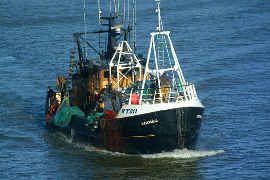 It has been estimated by the United Nations Food and Agriculture Organisation that over 70% of the world’s fish populations are either fully exploited or depleted.
It has been estimated by the United Nations Food and Agriculture Organisation that over 70% of the world’s fish populations are either fully exploited or depleted.
When talking about overfishing we usually use the term fish 'stocks' - as if fish were a product on the supermarket shelves. It is this idea that has led us to many of our world's problems today; that of seeing the natural world as a commodity - as a resource from which humans can take forever. Overfishing is one of the most dramatic examples of the devastating effects of our modern society's outlook on nature, and proof that our world's resources are not limitless.
Most of the problems associated with overfishing have been caused in the last 50 years by the growing human population demanding food and rapid advances in fishing technology. There used to be hundreds of trawlers and fishing boats based at ports like Peterhead, Grimsby and Great Yarmouth, but many of these have now been replaced by huge factory ships which are able to stay out at sea for weeks at a time. These factory boats have all the equipment necessary either to freeze or tin fish caught by their hunting ships, so that they need to return to base only when their holds are full.
With the introduction of the new factory boats, there was a 7% growth in catches every year during the 1950’s and 60’s, but since then there has been little increase in catch size and many of the world’s most important fisheries have closed down, with many more suffering so badly from overfishing that they are unlikely to recover.
As catches have gradually become smaller, so the mesh sizes used in fishing nets have decreased, allowing smaller and smaller fish to be caught. Many of these are too small to be used as food, so they are crushed to be made into either animal food or fertiliser.
Fishing using nets is indiscriminate. Any fish which get in the way of the net will be caught in it if they are too big to get through the mesh. For every tonne of prawns caught, three tonnes of other fish are killed and thrown away. 20,000 porpoises die each year in the nets of salmon fishermen in the Atlantic and Pacific Oceans and hundreds of thousands of marine creatures are killed each year by tuna fishermen.
How Commercial Fishing Works
Some sea fish live in the upper parts of the water. They are called ‘pelagic’ fish, and are caught by drift netting. This is where a net suspended from floats is stretched between two boats so that fish swim into it. Fish are unable to swim backwards, so once they are caught in the net, there is no escape unless they are small enough to fit through the net’s mesh.
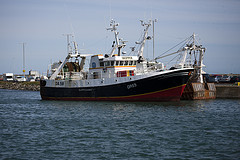 Fish which live lower down – mid-water and bottom-feeders – are caught by trawling, which involves dragging a large net through the water, catching whatever happens to be in the way. The size of the net holes is again very important, and it is vital for the conservation of fish stocks that nets with a very small mesh are banned, as these catch young fish before they have even had a chance to breed.
Fish which live lower down – mid-water and bottom-feeders – are caught by trawling, which involves dragging a large net through the water, catching whatever happens to be in the way. The size of the net holes is again very important, and it is vital for the conservation of fish stocks that nets with a very small mesh are banned, as these catch young fish before they have even had a chance to breed.
The ‘Cod War’ and Other Overfishing Incidents
In the 1970s a serious dispute broke out between British and Icelandic fishermen over the Icelandic cod fisheries. British trawlers continued to fish for cod despite a ban on fishing put into place by the Icelandic government, and there were confrontations between British and Icelandic trawlers, which became known as the “Cod War’. There is now a 100-mile exclusion zone around Iceland, in which foreign boats are not allowed to fish. Most cod on sale in Britain is sourced from Iceland and the Barents Sea.
In 2007, stocks of North Sea cod reached a historic low of 37,400 tonnes. Major conservation efforts including cuts in landing quotas resulted in a 52% recovery in 2010 with an estimated stock of 54,200 tonnes. This successful conservation project was reported in an article in The Independent.
However, this figure was still well below previous figures - 250,000 tonnes in the 1970s, for example. Stocks caught by English and Welsh boats are said to have declined by as much as 86% in 100 years.
Populations were deemed unsustainable by the Marine Conservation Society who want to see stocks increase further before consumers consider stocks from the North Sea. The International Council for Exploration of the Sea estimates between 70,000 - 150,000 tonnes are necessary for a full recovery. According to an article in the Guardian on 8 April 2015, "cod stocks are improving rapidly and could be certified as sustainable within five years,"
The legal amount of cod, which can be caught in 2020 by the UK’s fishermen, was halved from 2019 amounts . The decision was finalized at Brussels talks on fishing quotas for the coming year. The EU’s rules in the Common Fisheries Policy will apply until December 2020. After Brexit, regulation of the fishing industry in the North Sea will be controlled by the UK. However, even before those discussions, Scottish trawlermen representatives had agreed to a 50% reduction of cod that could be caught to preserve stocks.
Tuna Fishing
Tuna are very large fish that can grow up to half a ton or more and swim at fast speeds of 50mph. They are big sturdy creatures with plenty of meat on them which is sadly the reason for their decline.
 World catches of tuna have doubled in the last decade. Skipjack tuna, which is currently not at risk, is the most commonly used canned tuna, although yellowfin and albacore tuna are also used. At particular risk is the bluefin tuna, a slow breeder. The International Seafood Sustainability Foundation published a tuna stock status update in 2015
World catches of tuna have doubled in the last decade. Skipjack tuna, which is currently not at risk, is the most commonly used canned tuna, although yellowfin and albacore tuna are also used. At particular risk is the bluefin tuna, a slow breeder. The International Seafood Sustainability Foundation published a tuna stock status update in 2015
stating that bluefin tuna is heavily overfished and that the biomass is at historically low levels. Bluefin tuna is considered one of the most delicious in the world, and despite many campaigns worldwide to boycott the production, consumption and serving in restuarants of this fish, people's taste buds just can't say no.
There are two types of bluefin, the Atlantic/northern and the southern bluefin which is ranked on the IUCN Red List as critically endangered. In November 2014 the tuna subspecies Pacific bluefin was moved from Least Concern, to Vulnerable on the IUCN's Red List of endangered species. A worrying sign for the world's tuna populations.
It is considered a delicacy in Japan and China where it is thought to be the best fish for sushi and is exported to many other parts of the world. According to the IUCN, the International Commission for Conservation of Atlantic Tuna (ICCAT) adopted a resolution stating that the total annual commercial catch in 2014 should not exceed 5,000 metric tons, but countries with historical EPO catches of bluefin tuna may catch an additional 500 metric tons of Pacific bluefin tuna. This figure is still most likely exceeded with the actual amount being caught at an estimated 60,000 tons each year. The World Wildlife Fund (WWF) has called for a quota of 6,000 tons per year.
The fishing season for Atlantic bluefin tuna is May and June when they swim to the Mediterranean sea to spawn. It is suspected that quotas are often ignored and the true catch not reported. In 2010 the European Commision (EC) closed the fishing season one week early in order to preserve remaining stocks. Bigeye tuna is the next best alternative to bluefin tuna and is also noted as a vulnerable species. In 2012 it was reported that due to warming sea temperatures bluefin tuna were now also found off the coasts of the UK! See the section, Changing Seas for more information and to find out what other creatures this change in climate is bringing.
Japan consumes 1/4 of the world’s tuna and one bluefin tuna was sold there in 2012 for a whopping £472,125. Such is the overwhelming desire for bluefin tuna, scientists in Tokyo are researching a stem cell project to use mackerel as surrogate mothers for baby tuna - a way around tuna's slow breeding and maturity process.
Atlantic bluefin are listed by the IUCN as Endangered; Pacific bluefin are at historical lowest levels; and Southern bluefin are listed as Critically Endangered.
Dolphin Safe
 Tuna fishing received much publicity in the 1990s when a boycott led to changes in fishing practices to avoid catching dolphins which often swim alongside yellowfin tuna. They did this by fitting special hatches in the nets from which dolphins could escape.
Tuna fishing received much publicity in the 1990s when a boycott led to changes in fishing practices to avoid catching dolphins which often swim alongside yellowfin tuna. They did this by fitting special hatches in the nets from which dolphins could escape.
To combat the sale of tuna likely to involve dolphin catching you can look out for the 'dolphin safe' logo on tins of tuna at the supermarket. But be wary - this doesn't guarantee sustainable fishing practices are in use.
Skipjack tuna are more likely to be dolphin safe because they do not associate with dolphins. However the dolphin safe label does not guarantee the safety of other marine creatures such as sharks, rays and turtles. Between 60 - 70% of tuna are caught using the purse seine method. Usually they are lured by fish aggregation devices (FADS), floating devices which the tuna congregate under and the net is pulled up around them like a large drawstring bag/purse. In fact 10% of the catch using this method are unwanted bycatch, amounting to 100,000 tonnes annually. Some of the bycatch is made up of sharks, many of which are threatened species. Their fins are cut off to sell to make a Chinese delicacy - shark fin soup. Without the FADS, this method can be specifically targetted to a school of one adult species and avoids much of the bycatch.
Longline fishing is a method used to catch more expensive kinds of tuna. This method involves putting out fishing lines up to 100km long from which there are as many as one thousand shorter lines attached with baited hooks. This still indiscriminately kills untargetted marine life such as turtles (of which 6 out of 7 species are considered threatened) which are tempted by the jelly fish appearance of the bait. Abatrosses and other seabirds can also get caught on the hooks. An estimated 500,000 - 1.4 million sharks are killed every year this way.
The pole and line method and “trolling” (where baited lines are dragged through the water behind a boat) are considered as the most sensible methods of fishing as it targets the adult fish, bycatch is much reduced and unwanted catches can be returned to the sea, alive. This is often the chosen method of smaller fisheries.
Shark and Chips. Are endangered sharks being sold in a fish and chip shop near you?
 Did you know that people eat sharks in the UK? Probably not because they're not called sharks on the menu at the fish and chip shop. Every year tens of millions of sharks around the world are caught for our dinner plates in the United Kingdom, Europe, United States and beyond. But what are these mysterious creatures?
Did you know that people eat sharks in the UK? Probably not because they're not called sharks on the menu at the fish and chip shop. Every year tens of millions of sharks around the world are caught for our dinner plates in the United Kingdom, Europe, United States and beyond. But what are these mysterious creatures?
The sharks we refer to are known as spiny or piked dogfish, but menus call them 'rock salmon' 'rock' 'spurdog' or 'huss' because it sounds tastier! Millions of them are caught every year and this has given them a place on the IUCN's Red List of Engandered Species as Vulnerable - and no animal wants to be on that! Spiny dogfish can grow up to 1.3 metres long and live in shallow waters across the world. They are slow growers and take about 10 years to mature into adults and live for 40, sometimes 70 years! Because they grow slowly and babies remain in the womb for 2 years it takes a long time for them to re-populate and their numbers are falling drastically.
Another concern for sharks worldwide is the demand for shark fin soup, which is a delicacy brought to many countries, including the UK, from China where it is a soup for special occasions. To make this special soup in many cases, sharks are caught, their fins are cut off and then they are thrown back into the sea to drown and suffocate. This cruel practice has been going on for years. Altogether it is estimated that between 26 million and 73 million sharks are caught every year and that a quarter of shark and ray species, for which we have adequate data, are regarded as threatened with extinction.
What can you do to help? You can avoid eating rock salmon or shark fin soup in restaurants, cafes and fish and chip shops. As a class at school you could write to your local Chinese restaurant and, if they sell shark fin soup, ask them to take it off the menu.
For more information see the Stop Shark Finning website.
More Examples of Overfishing
It used to be a matter of luck whether fishermen would catch any fish at all, as fish are difficult to find, but now modern radar technology has allowed them to be located much more precisely than was possible before.
In Peru, anchovies were fished in huge numbers. In 1970, over 12 million tonnes of fish were harvested. However, by 1972, anchovy population had plummeted and less than 2 million tonnes were caught. It took the population over two decades to recover.
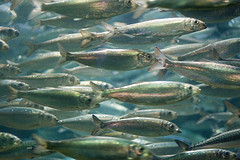 On the Dogger Bank, off the east coast of England near Great Yarmouth, overfishing caused the annual catch of herring to fall 30-fold in just 15 years. By 1966, only 10,000 tonnes of the fish were caught in the whole year. Further north, a ban was placed on herring fishing, and in 1977, a total ban was placed on herring fishing, throughout the North Sea. The ban lasted for six years. According to the IUCN, after the severe drop in numbers in the 1970s herring have recovered and are now classified as Least Concern.
On the Dogger Bank, off the east coast of England near Great Yarmouth, overfishing caused the annual catch of herring to fall 30-fold in just 15 years. By 1966, only 10,000 tonnes of the fish were caught in the whole year. Further north, a ban was placed on herring fishing, and in 1977, a total ban was placed on herring fishing, throughout the North Sea. The ban lasted for six years. According to the IUCN, after the severe drop in numbers in the 1970s herring have recovered and are now classified as Least Concern.
These are just a few examples of how overfishing can seriously affect not only the fish populations, but also the livelihoods of many people who depend on fishing as a job. There is a delicate balance to be struck between catching large numbers of fish so as to make more money and ensuring that there are enough fish left alive to be able to replenish populations for future years. The temptation is to make as much money as possible, but this has to be weighed against the economic hardship that whole communities have suffered as a result of overexploiting their own fisheries, not to mention the grave consequences of overfishing for fish populations. See our Biodiversity factsheet to find out about how everything is connected in nature.
The Effects of Overfishing on Other Wildlife
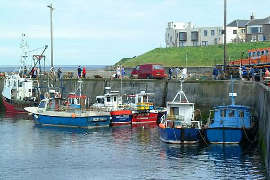 The overfishing of a particular species does not just damage the population of that fish alone. It can have serious effects further up the food chain. Herring is a vital prey species for the cod. Therefore, when herring are overfished the cod population suffers as well. The sandeel is the main food for seabirds such as the puffin. Sandeels have been fished around the Shetland Islands since the mid-1970s, though catches were declining throughout the 1980s. At the same time, the colonies of seabirds nesting around Shetland declined, with some even failing to breed for several years. Because of the low numbers of sandeels around the Shetland Isles in the 1980s, the fishery was closed periodically from 1989, reviewed annually and not reopened until 1995, at which time legislation made it necessary for fisheries to take account of wildlife conservation. It is not thought to have a significant impact on the number of sandeels available for seabirds.
The overfishing of a particular species does not just damage the population of that fish alone. It can have serious effects further up the food chain. Herring is a vital prey species for the cod. Therefore, when herring are overfished the cod population suffers as well. The sandeel is the main food for seabirds such as the puffin. Sandeels have been fished around the Shetland Islands since the mid-1970s, though catches were declining throughout the 1980s. At the same time, the colonies of seabirds nesting around Shetland declined, with some even failing to breed for several years. Because of the low numbers of sandeels around the Shetland Isles in the 1980s, the fishery was closed periodically from 1989, reviewed annually and not reopened until 1995, at which time legislation made it necessary for fisheries to take account of wildlife conservation. It is not thought to have a significant impact on the number of sandeels available for seabirds.
In the Antarctic, fishing for krill is threatening to disrupt the delicate balance of nature in these waters. Krill are small, red shrimps, about 6cm long, found in huge numbers in areas of plant plankton, and they make up a significant part of the animal plankton. Krill occur in huge swarms many kilometres across, and it has estimated that there could be up to 650 million tonnes of them in the Antarctic Ocean.
Since the early 1980s, six countries, including Japan and the former USSR have been harvesting krill, which is the main food for the great whales, and which also supplements the diets of seals, penguins, squid and fish. We have no idea what effects this will have on the populations of animals which feed on krill. The natural balance in the Antarctic has already been upset by the over exploitation of the great whales and heavy fishing of krill may well worsen the situation. Krill populations in the Antarctic are now declining.
Climate Change and Changing Seas
Warmer UK seas are attracting stingrays and other foreign species. Fishermen off the south and south-west coasts of the UK are finding species that you would normally find in the Mediterranean! Bluefin tuna, stingrays, thresher sharks and ocean sunfish are being spotted as sea temperatures rise.
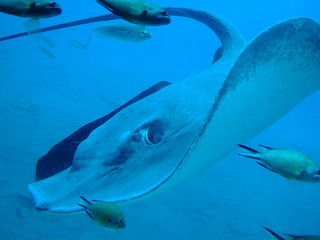 These new species are usually found in waters off Spain, France, Lanzarote and Tenerife. So why are they here? Climate change is being blamed for the rise of invasive species in UK waters as sea temperatures rise. Marine scientists are worried about the effects these new visitors will have on our marine environments. They may pose a serious threat to our native fish by increasing competition for food, and bringing with them new diseases.
These new species are usually found in waters off Spain, France, Lanzarote and Tenerife. So why are they here? Climate change is being blamed for the rise of invasive species in UK waters as sea temperatures rise. Marine scientists are worried about the effects these new visitors will have on our marine environments. They may pose a serious threat to our native fish by increasing competition for food, and bringing with them new diseases.
But it's not just a challenge for the fish. As we know, fishermen are already struggling under strict fish quotas limiting the amount of fish they can catch, and competition from other countries whose fish are on the move may cause fresh clashes and problems. Bluefin tuna in particular are extremely valuable in the seafood market, and they are now classed as a critically endangered species due to over fishing. In fact, many say that we should stop all catching of them completely until they've had time to recover.
World fish stocks are dwindling and there are very serious concerns that many fish species, which are vital food sources for millions of people may soon disappear forever. As climate change brings these new challenges there are even more reasons to be very careful with what we eat and what we catch to protect the oceans and their future.
What Can Be Done?
- Properly maintained fisheries could and should be a renewable and possibly even endless supply of protein. At present, short-term economic pressures are preventing sensible long-term planning for a sustainable yield (only taking out as many fish as can be replaced by reproduction the following year.)
- Quotas should be set on catches, based on scientific estimates for the size of the fish stock. Correct mesh size should be used in all nets to ensure that fish of the right age are caught, and to prevent as much as possible accidental catches of other fish. International agreements limiting catches are necessary to safeguard fish stocks for the use not only of humans but for marine animals as well. With these measures in place, fishing could continue without damaging stocks, and we could employ the world’s richest source of protein to everyone’s advantage.
- Tins of tuna should not only be marked as dolphin friendly, but wider considerations should be taken into account such as the method of fishing, the use of FADS and overfishing. There should be independent observers on board the ships all the time to check that they are sticking to the rules!
- Marine reserves which currently cover only 1% of the world’s oceans should be expanded to cover, some argue, up to 40%.
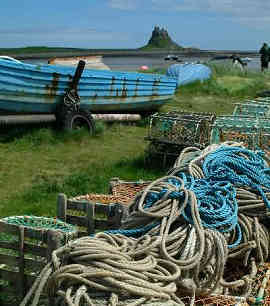 What you can do:
What you can do:
- Check the Marine Stewardship Council’s website to see which fish are sustainably caught and look for their stamp of approval when buying packets of fish, or you can search particular fish here.
- The USA is the world’s biggest consumer of tinned tuna followed by the UK (consuming 700 million tins in 2006). If you buy tuna, choose the most reputable brand. Sainsbury’s followed by CO-OP tuna were ranked by Greenpeace as the most responsible in where they source their tuna from. See how they ranked the tins: www.greenpeace.org.uk/oceans/time-and-tuna-are-running-out
- Look for dolphin safe tinned tuna rather than only dolphin friendly. The dolphin safe label awarded by the Earth Island Institute has the strictest monitoring system of fishing methods with an independent observer on board vessels over 400 gross tons. Dolphins must not be chased or harmed in any way, intentionally or otherwise.
- Operation Blue Rage - Bluefin Tuna Defense Campaign by Sea Sheperd
Further Information
For more information see:
Credits
Image: Over Fishing by Dave Johnston
Information sourced from:
Smith, Lewis (2015), The Guardian, North sea cod stocks bounce back, analysis shows [online], Available from: http://www.theguardian.com/environment/2015/apr/08/north-sea-cod-stocks-bounce-back-analysis-shows [accessed 05/07/2015].
Internation seafood Sustainability Foundation (2015), ISSF Tuna Stock Status Update - 20152 [online], Available from: http://iss-foundation.org/wp-content/uploads/downloads/2015/03/ISSF-2015-03-Status-of-the-Stocks-Feb-2015.pdf [accessed 05/07/2015].
The IUCN Red List of Threatened Species (2015), Thunnus maccoyii [online], Available from: http://www.iucnredlist.org/details/21858/0 [accessed 05/07/2015]
The IUCN Red List of Threatened Species (2015), Thunnus orientalis [online], Available from: http://www.iucnredlist.org/details/170341/0 [accessed 05/07/2015]
AFT, (2014), The Guardian, Governments agree 20% hike in Bluefin tuna catch [online], Available from: http://www.theguardian.com/environment/2014/nov/18/governments-agree-20-hike-in-bluefin-tuna-catch [accessed 05/07/2015].
The IUCN Red List of Threatened Species (2015), Thunnus Obesus [online], Available from: http://www.iucnredlist.org/details/21859/0 [accessed 05/07/2015]
Oceana (2015), Atlantic Bluefin Tuna and Cities [online], Available from: http://usa.oceana.org/sites/default/files/CITES_English_Bluefin_Fact_Sheet.pdf [accessed 05/07/2015]
European Commission (2015), Facts and figures: 2015 Bluefin Tuna Fishing Season [online], Available from: http://europa.eu/rapid/press-release_MEMO-15-5033_en.htm [accessed 05/07/2015]
The IUCN Red List of Threatened Species (2015), Squalus acanthias [online], Available from: http://www.iucnredlist.org/details/39326/0 [accessed 05/07/2015]
IUCN (2014), A quarter of sharks and rays threatened with extinction [online], Available from: http://www.iucn.org/?14311/A-quarter-sharks-and-rays-threatened-with-extinction [accessed 05/07/2015]
The IUCN Red List of Threatened Species (2015), Clupea harengus [online], Available from: http://www.iucnredlist.org/details/155123/0 [accessed 05/07/2015]
The Scottish Government (2010), Sandeels [online], Available from: http://www.gov.scot/Topics/marine/marine-environment/species/fish/sandeels [accessed 05/07/2015]
Antarctic and Southern Ocean Coalition (2014), Krill Conservation [online], Available from http://www.asoc.org/advocacy/krill-conservation [accessed 05/07/2015]
 It has been estimated by the United Nations Food and Agriculture Organisation that over 70% of the world’s fish populations are either fully exploited or depleted.
It has been estimated by the United Nations Food and Agriculture Organisation that over 70% of the world’s fish populations are either fully exploited or depleted. 
 Fish which live lower down – mid-water and bottom-feeders – are caught by trawling, which involves dragging a large net through the water, catching whatever happens to be in the way. The size of the net holes is again very important, and it is vital for the conservation of fish stocks that nets with a very small mesh are banned, as these catch young fish before they have even had a chance to breed.
Fish which live lower down – mid-water and bottom-feeders – are caught by trawling, which involves dragging a large net through the water, catching whatever happens to be in the way. The size of the net holes is again very important, and it is vital for the conservation of fish stocks that nets with a very small mesh are banned, as these catch young fish before they have even had a chance to breed. World catches of tuna have doubled in the last decade. Skipjack tuna, which is currently not at risk, is the most commonly used canned tuna, although yellowfin and albacore tuna are also used. At particular risk is the bluefin tuna, a slow breeder. The International Seafood Sustainability Foundation published a tuna stock status update in 2015
World catches of tuna have doubled in the last decade. Skipjack tuna, which is currently not at risk, is the most commonly used canned tuna, although yellowfin and albacore tuna are also used. At particular risk is the bluefin tuna, a slow breeder. The International Seafood Sustainability Foundation published a tuna stock status update in 2015 Tuna fishing received much publicity in the 1990s when a boycott led to changes in fishing practices to avoid catching dolphins which often swim alongside yellowfin tuna. They did this by fitting special hatches in the nets from which dolphins could escape.
Tuna fishing received much publicity in the 1990s when a boycott led to changes in fishing practices to avoid catching dolphins which often swim alongside yellowfin tuna. They did this by fitting special hatches in the nets from which dolphins could escape. Did you know that people eat sharks in the UK? Probably not because they're not called sharks on the menu at the fish and chip shop. Every year tens of millions of sharks around the world are caught for our dinner plates in the United Kingdom, Europe, United States and beyond. But what are these mysterious creatures?
Did you know that people eat sharks in the UK? Probably not because they're not called sharks on the menu at the fish and chip shop. Every year tens of millions of sharks around the world are caught for our dinner plates in the United Kingdom, Europe, United States and beyond. But what are these mysterious creatures? On the Dogger Bank, off the east coast of England near Great Yarmouth, overfishing caused the annual catch of herring to fall 30-fold in just 15 years. By 1966, only 10,000 tonnes of the fish were caught in the whole year. Further north, a ban was placed on herring fishing, and in 1977, a total ban was placed on herring fishing, throughout the North Sea. The ban lasted for six years. According to the IUCN, after the severe drop in numbers in the 1970s herring have recovered and are now classified as Least Concern.
On the Dogger Bank, off the east coast of England near Great Yarmouth, overfishing caused the annual catch of herring to fall 30-fold in just 15 years. By 1966, only 10,000 tonnes of the fish were caught in the whole year. Further north, a ban was placed on herring fishing, and in 1977, a total ban was placed on herring fishing, throughout the North Sea. The ban lasted for six years. According to the IUCN, after the severe drop in numbers in the 1970s herring have recovered and are now classified as Least Concern. The overfishing of a particular species does not just damage the population of that fish alone. It can have serious effects further up the food chain. Herring is a vital prey species for the cod. Therefore, when herring are overfished the cod population suffers as well. The sandeel is the main food for seabirds such as the puffin. Sandeels have been fished around the Shetland Islands since the mid-1970s, though catches were declining throughout the 1980s. At the same time, the colonies of seabirds nesting around Shetland declined, with some even failing to breed for several years. Because of the low numbers of sandeels around the Shetland Isles in the 1980s, the fishery was closed periodically from 1989, reviewed annually and not reopened until 1995, at which time legislation made it necessary for fisheries to take account of wildlife conservation. It is not thought to have a significant impact on the number of sandeels available for seabirds.
The overfishing of a particular species does not just damage the population of that fish alone. It can have serious effects further up the food chain. Herring is a vital prey species for the cod. Therefore, when herring are overfished the cod population suffers as well. The sandeel is the main food for seabirds such as the puffin. Sandeels have been fished around the Shetland Islands since the mid-1970s, though catches were declining throughout the 1980s. At the same time, the colonies of seabirds nesting around Shetland declined, with some even failing to breed for several years. Because of the low numbers of sandeels around the Shetland Isles in the 1980s, the fishery was closed periodically from 1989, reviewed annually and not reopened until 1995, at which time legislation made it necessary for fisheries to take account of wildlife conservation. It is not thought to have a significant impact on the number of sandeels available for seabirds.  These new species are usually found in waters off Spain, France, Lanzarote and Tenerife. So why are they here? Climate change is being blamed for the rise of invasive species in UK waters as sea temperatures rise. Marine scientists are worried about the effects these new visitors will have on our marine environments. They may pose a serious threat to our native fish by increasing competition for food, and bringing with them new diseases.
These new species are usually found in waters off Spain, France, Lanzarote and Tenerife. So why are they here? Climate change is being blamed for the rise of invasive species in UK waters as sea temperatures rise. Marine scientists are worried about the effects these new visitors will have on our marine environments. They may pose a serious threat to our native fish by increasing competition for food, and bringing with them new diseases.  What you can do:
What you can do: